
Hi everyone!
Here are The Magic Memories #44, gone online SUN, 31st October 2021, at 0:07h.
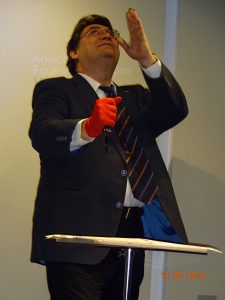
Comments on the “Magialdia Show”

Hi everyone!
Here are The Magic Memories #44, gone online SUN, 31st October 2021, at 0:07h.

Comments on the “Magialdia Show”

Hi everyone!
Here are The Magic Memories #43, gone online SUN, 24th October, at 0:07h.
Trivia
I think I’ve never mentioned this, but will do here since a few have asked: The cards in the title logo are of course in Tamariz Mnemonica Order, what else?
Trip Notes
I promised to tell you a bit about my long car ride from Muttenz, Switzerland to the Magialdia Convention in Spain, the latter reported in The Magic Memories #42. On the way there I made a stop to visit with my friend Olivier Cave, who lives near St. Etienne in France, and whom I had met a few times at the Escorial Card Conference years before. I finally had a change to spend the afternoon and evening with this remarkable man. The photo below shows us perusing a few of his books. In the background are just a few of his hundreds of books on the subject of gambling and cheating. Olivier has one of the most exquisite collections I’ve ever had the pleasure of seeing, and he’s to be congratulated for all the time and expertise he’s putting into it.

Olivier is not just a passionate collector, but also a blessed scholar in the matter, and as if that wasn’t good enough, he also excels in the knowledge and execution of almost everything that is written up in those books, including some of the most difficult sleights. Maybe an organizer of magic conventions will one day have the foresight to book him for one of his rare lectures and demonstrations on the subject. In the photo below you can see Olivier smiling after having successfully dealt himself a winning hand, and myself with a puzzled look 🙂
A wonderful dinner in the company of his beautiful family rounded up a unique day with a truly extraordinary person. We promised to see each other soon again to continue our discussions on the infinite topic of gambling and cheating, as well as magic, naturellement.

Notes on Gambling & Cheating in Magic
The above triggered a few more thoughts on the matter. Without considering myself an “expert” in the field of gambling and cheating, I still have taken an early interest in the subject and accumulated and studied hundreds of books, videos and documents. For years my major source was the “Gambler’s Book Club” in Las Vegas: They used to send out their catalogue at least twice a year, and whenever I received one, I sent for a big order.
Among other things I found biographies of gamblers, more often than not from so-called “reformed” scoundrels, to be of great interest. If you are curious about this, I will recommend just two books (so as not to scare you off): One, Carlton Stowers The Unsinkable Titanic Thompson, two, George H. Devol’s Forty Years a Gambler on the Mississippi, both truly engaging and marvelous stories about two “characters”. Not only will you spend some entertaining and instructional reading hours, you will also be spoiled for ideas to use as presentations for your gambling-themed tricks: Several of the anecdotes told there make for ideal Prologues, or you can just tell them in-between tricks, especially in longer pieces.
For the note-takers among you: Open a note titled “Gambling-themed Tricks in Card College” (and other books…). Looking through the five volumes you’ll find quite a few, as well as items that with a change in presentation can be adapted to the theme. And if you’re looking for a ready-made routine go to Card College Volume 5 and work through “Fantasist at the Card Table”. Although the routine requires a set-up deck, two comments are in order:
I created this routine after reading a much simpler version in Ted Annemann’s JINX many years ago. My first solution was my second publication in my “writer’s career” and published under the title of A Gambler’s Dream by Martin Breese in London (1986). At that time I was spending a semester in London and Cambridge for my language studies, and became quite friendly with Martin, who at the time was an important dealer in the magic market, besides being a very charming and encouraging gentleman. Anecdotally, I should mention that I submitted a book project of mine to him a year or so later, and he refused to publish it. He had given it to David Britland, who was his unofficial technical advisor and who found the manuscript not up to par – and he was right 🙂 as I will readily admit today, but then I was certainly a bit disappointed. The consequence of it was, of course, that when I had published the original version of Card College in German (Grosse Kartenschule), and was looking for a publisher, I did not ask Martin but Stephen Minch of Hermetic Press fame. Had Martin accepted my first (inadequate!) book, I would obviously have asked him first, and he would then (maybe) have been the publisher of what seems to have become one of the most successful book series in magic history. Talk about the Butterfly Effect… Oh, and the JINX I mentioned above: If you are looking for something to take to your two-week vacation, get the three bound volumes of this amazing magazine and you might just spend your magically most memorable vacations…
Since I mentioned my “second” publication above, some may wonder which one was my first. Well, it also happened during my stay in London: Every Monday I (obviously!) went down to the Magic Circle. Although not a member, having attended Ron MacMillan’s One Day Conventions before, as a visitor and then as one of their youngest ever booked “acts”, I had become friendly with various of the MC members, such as Ian Keable, Chris Power and Johnny Johnston aka “JJ”, and was thus granted access to the premises of the famous Magic Circle. BTW: This was and still is certainly the most well-known club in the UK, and maybe in the world among lay people. I vividly remember that when I first did a trick for the landlady I was staying with during my study stay, she immediately asked, “Are you a member of the Magic Circle?” I never got that type of question in any other country I’ve been to, and I’ve been to many…
Anyway, on those Mondays the “real magic” did not happen at headquarters, then at 84 Chenies Mews and now in Stephenson Way, but at the pub round the corner, the Marlborough Arms, more specifically at the bar at the back, the Blenheim Bar (where the 12-year-old Glenfiddich cost £1!). That’s were the really interesting people gathered. I remember my regular sessions with Eric Mason, Fred Robinson, Ali Bongo and of course the chaps my age, Ian, Chris, JJ, Richard (MacDougal) and a host of others I forget. One of them was Walt Lees, an incredibly skilled card and close-up magician, who professionally made a living from children’s magic (yes, that did surprise me, too). Walt was at that time the editor of the legendary British publication Pabular (you are well advised to get a paper or electronic copy of this truly great magic magazine).
He was very kind and encouraging to me, something I’ll always remember thankfully, and he asked me for a few contributions to the magazine. So I did (some of it several years later made it into my Card College books). He liked four items particularly well and suggested to make them into a separate booklet, which then became The Cardmanship of Roberto Giobbi, in 1984 my very first “real” publication (I had previously contributed items to some Swiss, German and Austrian magazines). The publisher of it was “Magico Magazine” owned by one Samuel Gringras of New York City, to this day referred to by all I spoke to as “The Rabbi”. As far as I can remember, we never met, but he managed to put a printer’s error on the title page: “The Cardmandship of Roberto Giobbi” – the “d” is wrong, of course. The “funny” thing was that the first edition apparently sold out quickly (he must have printed just a few…), so he did a second edition, but even though Walt and I had told him about the misprint on the title page, he kept it and republished the booklet tel quel. I’m told famous stamps and coins get higher values if they have some kind of blemish, so I fool myself into believing that some 100 years after my death this will be a rare and sought-after item.
Ah, so many memories, so little time to tell, and only a few care 🙂 I wanted to tell you a bit about my participation at the Swiss Youth Convention, and maybe about the Swiss national Magic Convention I’m going to with my friend Claudio Viotto tomorrow. Let’s see if it works out…
Have a great week!
Roberto Giobbi

Hi everyone!
This is #42 of The Magic Memories, gone online SUN, 17th October 2021, at 0:07.
Boring (Card) Tricks
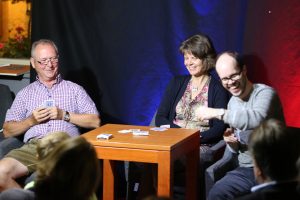
PS: If you want to say “Thank you” in a tangible way, buy something from the webshop. We’re still in Corona times with very little work, if at all, and I’m sure there must be an item that you don’t have. Now is the moment to get it 🙂

Hi everyone!
Here we are at #41 of The Magic Memories, gone online SUN, 10th October 2021, as always at 0:07.
As promised in the last two posts I will tell you a bit about the latest magic convention I went to, Magialdia, in Vitoria, the capital of Alava, a small hour from Bilbao, the capital of the Basque Country in the north of Spain. Magialdia is not just a convention, but a true magic festival lasting 3 weeks, the last three days being a magic convention that usually attracts ca. 400 magic enthusiasts from all over the world, the majority from Spain, of course. This year, due to Corona, the capacity was limited, but it did sell out and played to ca. 250 happy conventioneers.
This year Magialdia was in its 33rd edition, making it possibly the oldest such event in Europe, and certainly one of the longest-running in the world. What many will find surprising is that the event is mainly sponsored by the city of Vitoria, plus a few others, such as Fournier, the playing card company founded and located in precisely this city (and that’s another story). This is of course sensational, not just because it allows for a superb program with the best international artists, but also because it officially recognizes magic as a worthy artistic and cultural event, similar to festivals for Jazz, ballet or theatre. This is owed to a large part to its organizer from the first day, José Angel Suarez, and his exceptional team. That, naturally, is the secret for any successful convention: have a well-attuned team, i.e., always the same people who get along splendidly with each other, and where each one knows what to do.
Many things are absolutely remarkable about this festival, and if you are a booked act, you’ve never been treated as royally as at this convention. I won’t mention all the benefits you enjoy as a performer, as it would put all other convention organizers to shame, and this is certainly not my intention. However, may I say that if had to organize a convention I would go to Magialdia, make careful notes on how they handle things, and then imitate everything they do, including inviting all performers on the day after the convention to a full-day tour to the Rioja wine region, with visit to one or two wineries, some historical sites, and invite them (“inviting” meaning that people don’t have to pay) to a sensational lunch, including some of the great wines from Rioja. The photo below is taken on one of these legendary excursions. You will be able to recognize various well-posted magicians, such as Max Maven and the late Ramon Rioboo.

And here is yet another photo, overseeing the gorgeous Rioja valley, where some of the best wines in the world come from, with more stars of magic you might recognize, among others Toni Cachadiña, Yves Carbonnier and Gabi Pareras, one of the rare geniuses in magic.

I’ve had the privilege of being an invited guest to this conventions for the past fourteen years, and I haven’t missed one, occasionally turning down lucrative engagements, just to be with my friends at Magialdia. On some occasions I have performed and lectured, often together with a few of my friends, on Sunday morning, with talks that were off the beaten path. In the photo below you can see, from left to right, Jesus Etcheverry (the author of the Ascanio books), Toni Cachadina (FISM award winner in Close-up and Card Magic), Joaquin Matas (famous professional in Spain, here in a medieval costume, as he had just recreated a Cups & Balls routine from the oldest Spanish magic book), Manolo Tena (one of the greatest collectors of old magic books), and an unknown…
This was taken at the end of a 90-minute talk on the history of card magic literature in Spain. The following year I gave a 60-minute lecture all by myself in the Playing Card Museum to a very appreciative lay audience. I wish I could give this talk in other places, too, but most convention organizers just lack the vision to include such events in their conferences, which mostly are just magic gatherings directed at amateurs who want to have fun. I should hasten to add that I believe this is a gross misunderstanding, for especially nowadays we do have a large number of people who are not professional performers, but who are very well-informed and educated, and who would enjoy conventions to be less trivial than they often are. I do not write this to bash anyone, mind you, as this is not what I do, but because I have attended hundreds of conventions since the age of 17, and that’s now almost 45years, so I know what I’m talking about.

Back to facts: During Magialdia, and before the magic convention part starts on the last week-end, there are dozens of activities. Magic in pubs and cafés, magic-related movies with introductory talks by university professors, workshops for children, special “magic menus” in various restaurants, expositions in the public library and a large etcetera. Since I mentioned restaurants: The Basque cuisine is one of the best in the world, period. Below is a little film-photo clip by my friend Toni Cachadiña that shows only happy faces, and that’s what it is all about.
Back to the program: Another thing they do is that they put some really good performers in historical places within the old town center, each venue having a unique atmosphere. This year they had Ricardo Rodríguez (Chile), Joaquín Matas (Spain), Pipo Villanueva (Spain), Roberto Mansilla (Argentina) and Roberto Giobbi (Switzerland & Italy). I had the privilege of acting in the beautiful Fournier Playing Card Museum, next to the one in Issy-les-Moulineaux (Paris) the most remarkable museum of its kind. I did three shows of 25 minutes each on two consecutive days, total six shows, for an audience of 30 spectators each time (as everywhere the number of spectators in the audience had to be reduced due to Corona, with everyone wearing masks and keeping a distance of about one meter to each other). In spite of these sub-optimal conditions, the event went over well. As you might imagine it is much harder to get the normal reactions from a “masked” audience, that is aware at all times of their distance to each other and the artist. An additional difficulty for me was that I had last performed in November of 2020, almost one year away! This has never happened before in my life as a performer (and I’ve been a professional since 1988). Plus I had to cope with the Castilian language, the one I speak least well of the six I master. I admit that in such instances I turn back to scripting, which I usually only use rarely, to make sure I get all the lines and special vocabulary, which is part of my performing style in several languages. I would say that I lost about 25% of the reactions, but thanks to the program I had selected, and to the decades of experience, it went over much better than I had expected. I stuck to the age-old formula of three routines: A visual beginning (a rope routine in nine phases with audience interaction after about 3 minutes), another visual but intriguing middle that considered the fact of a heterogeneous audience including children (Vernon’s “Symphony of the Rings” with bits Richard Ross personally taught me), and a rather conceptual finale with a strong finish (my “Stickler”, the card stabbing routine from my book Stand-up Card Magic).
During the festival there are other unique events, one of the most unusual being what they call “Magia en los escaparates” (“Magic in the window displays”): Seven or eight shops in the heart of the city empty their main window and let a magician or magicienne set up their little stage and perform. The audience sits and stands outside on the sidewalk and enjoys the show, which is mostly visual to music with loudspeakers outside of the window. Occasionally some have experimented with interactive acts with patter and were quite successful with it. The acts are often top acts from all around the world. In the past they had Otto Wessely, Sylvester the Jester, Miguel Muñoz, and so many others. One year a sponsor even offered a prize of 10’000 EURO (ca. $ 11’500) for the best act, so the event turned into a competition (with eight competitors). The first prize went to Armando Lucero, who had come all the way from Las Vegas. In the photo below you can see the audience in front of a window, plus the jury of three seated in the middle, from left to right: Joanie Spina, Roberto Giobbi, José Angel Suarez.

Three other events for the public stand-out: First, a two-hour close-up gala in an amphitheater-like setting, were all convention activities take place, with an international cast, this year with Tom Stone, Ricardo Rodriguez and Roberto Mansilla, among others, presented in a hilarious way by one of Spain’s TV comedy and magic stars, Jandro. Two: a 90-minute magic variety show in Vitoria’s oldest and most beautiful classic theater, again with an international display of performers, and finally, on Sunday night, the closing night, they set up a huge stage such as the ones you see for large music concerts, and they put up a ca. 75-minute show in the large Plaza amidst the historical center of the city, with over a thousand spectators in attendance. Due to Corona last year and this year they had to move to yet another more modern theater with less capacity, but I’m confident that they’ll return next year.
And I haven’t even told you about the convention program for magicians! Fortunately I could attend the various galas, and also saw Roberto Mansilla’s excellent lecture. Unfortunately I missed several other activities due to Paul Wilson asking me to give lengthy interviews for his upcoming documentary on the life and magic of Juan Tamariz. However, if that turns out well I’ll forgive him 🙂
As you can see, next year you should leave everything you’re doing and come to Magialdia in September – and don’t forget to take a few extra days to visit one of the most interesting countries of the Old World, Spain, where some of the most innovative magic is created and performed.
Until next Sunday I wish all of you a successful and happy week!
Roberto Giobbi

Hi everyone!
Here we are with another edition of The Magic Memories, namely number 40, gone online on SUN, 3rd October 2021, at 00:07 o’clock – and as I’m writing this it is the premiere of the latest James Bond movie “No Time to Die”, what a coincidence…
The Program is Wild – Discussion
Thank you for all the nice comments I received on last weeks contribution, “The Program is Wild”. This encourages me to publish the sequel to it, i.e. the discussion and explanation of the performance you saw. There are really a lot of ideas in this clip, which is the beginning section of my Magic Apple Zoom Lecture (June 2021). The idea with the double-deck case has quite a bit of potential, especially the one with the “invisible/imaginary” deck next to the real performance deck.
To make things easier, I’ll report my drawings below, which you may use, or take as a point of departure for your own creations:

And here is how the box looks that I’m using for the program, with the “instruments” in the “false bottom” (maybe another presentational idea?):

Idea for a Short Act
As for the “Wild Program”, using just four apparently double blank cards, drawing a magic wand on one, and then making three “instruments” appear on each of the other three cards, makes for a lovely overture to a short (or long) little act. This obviously has a very open architecture, leaving space for all kinds of interpretations. But if you ask me for an opinion, I would go with “coins” (representing money), “rope” and “cards”. I would then open with “Paper to Money” and follow with “Gipsy Thread”, both are explained with all the details of handling and performance I gathered after 30 years (at least) of professional experience almost all over the world in my third Penguin video “The Act”. Close this little act with a third trick using playing cards. This will give you a nice compact “impromptu” close-up show of ca. 15 minutes (depending on the card trick). If you have more time, the first two trick, being visual in nature, will allow you to now continue with a solid card act. Card tricks, being mostly conceptual in nature, are best performed after the attention has been caught with shorter and more visual pieces – this is rule that has its exceptions… My choice for a lengthier card section would be “The Color-changing Deck” (Card College 5, p. 1333), followed by Williamson’s “Torn and Restored Transposition”, p. 72 in his Williamson’s Wonders (you can place the duplicate cards necessary immediately under the double-back thick card needed in the “Cold-changing Deck”), finally closing with “The Joker Folds up” (Card College 5, p. 1349. This would make quite an act 🙂
To watch the video CLICK HERE.
Have an enjoyable week!
Roberto Giobbi

Hi everyone!
This is #39 of Roberto Giobbi’s The Magic Memories, gone online SUN, 26th September 2021, at 0:07 o’clock.
Elmsley Gag Photo
I had a few inquiries about last post’s photo, which was obviously an allusion at Elmsley’s “Four-as-four Count” aka “Elmsley Count”, where you don’t see the third person, but you see the first twice. Sort of a visualization of the joke that was making the rounds as the four Elmsley videos by L&L Publishing saw the light of day. The joke went like this: A magician asks another, “Did you already see the four Elmsley videos?” “Yes, however, I did not see the third one, but I saw the first twice.” Verrrrry funny.
Anyway, below is the real photo, showing the “hidden” subjects, Italy’s Aurelio Paviato and Swiss-American Ron A. Wohl. This was taken on the occasion of the Jornadas Cartomagicas of the Escuela Magica de Madrid, the legendary yearly card convention held in San Lorenzo de El Escorial (near Madrid), this one being dedicated to the work of Alex Elmsley, who honored all of us with his presence. The photo was taken with the camera of my friend Aurelio, if my memory serves me right, and we were dining at “La Cueva”, a favorite restaurant we often went to with Ascanio, Tamariz and many other luminaries of the card universe.
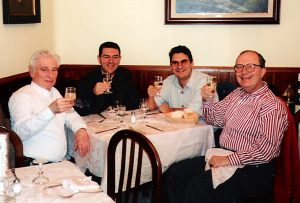
Opener for a Close-up Performance
I’m finally back from a lengthy travel to the Magialdia Magic Convention in Vitoria, which due to Corona restrictions was a bit different than usual, but as wonderful as ever – I will tell you about it and the trip in an upcoming post. Today, however, I will leave you with a “teaser”, in the sense that it will be a performance only video clip from my Magic Apple Lecture. It is an idea of how to open a little or even bigger close-up performance or act. I already described the original idea of it in my Secret Agenda, and for the convenience of those among you who are still resisting buying it 🙂 , here is the link to the entry in form of a PDF, CLICK HERE, please, to see how this all started (it is a very quick one-page read).
In the video you’ll see the opening sequence and the first performance piece from my Magic Apple Zoom Lecture. It is a personal interpretation of a Wild Card idea used by both Japan’s Shigeo Takagi and Holland’s Fred Kaps. A first version can be found in my book Secret Agenda, entry of AUG 29 (see above). The discussion and explanation of it will be found in my upcoming The Magic Memories (40), in the non-public section of my YouTube channel.
To watch the video clip of “The Program is Wild” CLICK HERE.
I’m off to the Youth Convention sponsored by the Magischer Ring der Schweiz, this time only at one hour card drive away, where I’ll be the keynote speaker, and look very much forward to meeting people aged 13 to 20 who are relatively new to magic, and to enjoy their talent (some of them already do amazing things).
Have an excellent week!
Roberto Giobbi

Hi everyone!
It is SUN, 19th September 2021, as the 38th edition of The Magic Memories goes online at 0:07…
Like the previous post (37), you are receiving this one thanks to the automation function of WordPress. Because, yes, I am right now on the road back from the Magialdia Magic Festival in Vitoria, another 1’200 kilometers, about 750 miles, in two days. On the way back I plan on visiting my good friend Marc Serin, an ophthalmologist by profession, but also an inspired amateur magician, living in Carcassone, in the midst of beautiful South of France.
The plan is for me to tell you a few things about the convention, which is possibly Europe’s (the world’s ?) oldest magic festival, and my travels and the people I met, in the next post, ie., The Magic Memories (39). Nowadays they do this real-time with all those fantastic (?) “social media”, and they do it at the same time they are watching a magic lecture or performance, or while they are eating or even talking to someone. Since I’m still “old school” I do all the aforementioned individually , enjoying them fully, and later I’ll let you know about it. Hope that’s OK 🙂
As for this week’s little gift to you, I just decided to take it “light”, as in the Card College Light series, and make it “just” a photo. Obviously, being a person who loves sophistication, like yourself, my dear reader, it won’t be just any photo, but a “special” one. For those who know, no explanation is necessary, for those who don’t, no explanation will suffice.

Hope to meet you back here next Sunday – and meanwhile have a great week!
Roberto Giobbi

Hello everyone!
Recently someone on the Internet posted this quote of mine, which I had completely forgotten about, but thought it would make a nice intro to today’s The Magic Memories #37, gone online on SUN, 12th September 2021, as always at exactly 0:07 o’clock. And here’s the quote:
“An artist is an inspired individual who has found his vocation. Through his work he not only gives a meaning to his own life, growing as he practices his art, but he also contributes to the world and the life of others. Art is passion communicated with inspired talent.” (Roberto Giobbi)



Hi everyone!
Here we go with nr. 36 of The Magic Memories, gone online on SUN, 5th September 2021, at, yes, of course, 0:07!
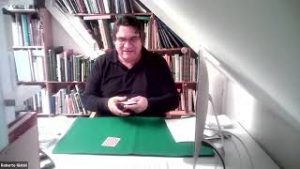
This week’s offering is another excerpt from the Zoom-lecture I did for The Magic Apple on SUN, 18th July 2021, and it features “The Guarantee Joker”, that albeit a minor trick, harbors some interesting technical, presentational and conceptional ideas useable in many other tricks. This polyvalence is in my opinion the true value of this and similar tricks. In all of my books and lectures I aspire to these qualities. Because then you do not just get a “new trick”, which you might or might not like, and even if you like it, you might not do, but you get to know new tools that you can use to shape your own creations, or reshape and improve your old ones. That’s the idea.
As most of the other clips from the lecture I’ve uploaded up to now, this one deals with a particular characteristic of my Card College Playing Cards, namely the Joker. The deck has two Jokers, a “big Joker” and a “small Joker”, the latter being at the same time the “Guarantee Card”. Years ago it occurred to me to use Bicycle’s “small Joker”, which also has a guarantee text from the manufacturer on it, as a presentational idea: I would misread (artistic license) the text as saying the manufacturer guarantees that all magicians using their decks would never miss a trick performed with them. This led to a few interesting pieces that I’m using to this day, e.g., “Card Call” from Stand-up Card Magic.
In the Card College Playing Cards deck, though, I’ve created a specific text that you can see in the illustration of the Joker below. This allows for some novel presentations, or just as a gag. As I’ve mentioned in my previous blogs that dealt with the characteristics of my deck, you can of course do almost all with other decks, too, just “use your head”, to quote Dai Vernon, and you’ll find how.
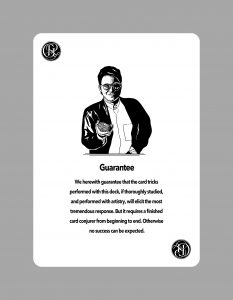
And before we leave, here is a little bonus idea: Place a second “big Joker” in the deck you use. You will hen have three Jokers, two identical ones and one Guarantee Joker. With the two identical Jokers you ca do some veeeery interesting things, but we’ll leave that as a koan (and a new note in your notebook that might read: “Duplicate Joker – Things to do with it…”).
To watch the video CLICK HERE. I hope you like it.
Wish you a healthy and inspired week!
Roberto Giobbi

Hi everyone!
As we go online with The Magic Memories #35, it is SUN, 29th August, 0:07 o’clock.

It is a hot day today, as it probably is in many parts of the world, the cards stick to the hands, the stacked pile of coins held in Classic Palm cannot be released reliably, therefore we need to cool down from inside. What better way of doing so than with an ice-cold soup. However, not any soup, of course, but a Watermelon Gazpacho. Anyone who will take 15 minutes of his or her time will be able to make this up and impress your partner, kids, guests, well, anyone whom you care to invite to your table.
Magic and Gastronomy have many things in common, last but by no means least, the moment when you sit with your guests and share a unique moment that will never come back in exactly this way, a moment where you present your passion, and then experience it together with your fellow human beings. The English, when they invite guests over for dinner, say, “We entertain them.” Very much like magic 🙂
To watch the video and start preparing the delicious Watermelon Gazpacho CLICK HERE.
Next week-end I’ll be back with some “real magic” :-), well, the way you probably expect it from me…
Have a great week!
Roberto Giobbi